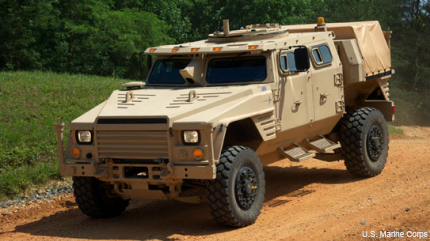Self-healing paint could save Navy billions
Polyfibroblast, developed by Johns Hopkins and ONR, lets vehicle surfaces heal the way skin does and prevents corrosion to the metal underneath.

The Marines first plan to use the paint on Joint Light Tactical Vehicles.
A new additive designed specifically for military vehicles would allow paint to heal itself after incurring scratches and other scars. And it’s not just for cosmetics purposes—the self-healing paint can prevent corrosion, which costs the military billions of dollars a year.
The additive, called polyfibroblast, was developed by the Johns Hopkins University Applied Physics Laboratory in partnership with the Office of Naval Research and can be added to everyday paint primers. It’s a powder consisting of microscopic polymer spheres, each filled with an oily liquid, according to a release from ONR. When damaged, the spheres release resin that forms a waterproof coating that protects the metal beneath the paint from corrosion. In essence, it heals that way human skin does.
Other self-healing paints exist, but they’re mostly intended to keep up a vehicle’s appearance. Polyfibroblast is designed to prevent corrosion to military vehicles in harsh environments. “We don’t care if it’s pretty,” said Dr. Jason Benkoski, senior scientist at Johns Hopkins’ lab and lead researcher on the project. “We only care about preventing corrosion.”
Corrosion—whether resulting from sunlight or sea salt, heavy weather or rough terrain—is a common problem across the Defense Department, which issues regular reports on its costs. The Navy estimates the cost of corrosion to be $7 billion a year, about a half-million of that in damage to Marine Crops ground vehicles such as the Joint Light Tactical Vehicle (JLTV). Across DOD, the annual tab runs in excess of $20 billion.
A paint that prevents rust would be worth something. “This technology could cut maintenance costs, and, more importantly, it could increase the time vehicles are out in the field with our Marines,” said Marine Capt. Frank Furman, who manages logistics research programs for ONR’s Expeditionary Maneuver Warfare and Combating Terrorism Department.
Polyfibroblast has been tested in a variety of settings, including an extended time inside a salt fog chamber that mimics what vehicles go through when being transported or stored aboard a ship, one of the prime causes of deterioration. The tests showed that polyfibroblast could protect vehicles for up to six weeks in that kind of environment.
Work on the paint additive began in 2008. The Marines first plan to use it on JTLVs scheduled to replace old Humvees. But that could be just the beginning, as the military could use it on anything that suffers from rust.




